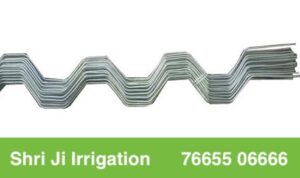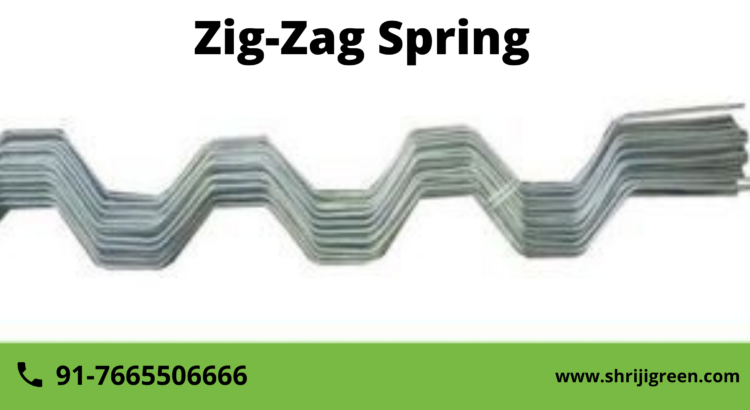Zig Zag Spring keep things moving, whether it’s the coil in your watch or the bounce in your step. Zig Zag Spring also serves to keep your polyhouse tarp from blowing away in the wind. To this, we think that’s pretty important, too! If you haven’t heard about them before, zigzag springs are an easy way to protect your polyhouse from the elements and ensure that it will stay in place for as long as you need it to.
Zig Zag Spring for Greenhouse
Once you’ve purchased your polyhouse, one of the first things you’ll want to consider is how to keep it safe from the elements. If you live in an area with strong winds, heavy rains, or even tornadoes and hurricanes. It’s vital that you take steps to protect your investment, which can cost thousands of dollars. Installing zigzag springs on your polyhouse ensures that when the wind blows or rain comes down in torrents, the enclosure will stay strong and protect everything inside from harm’s way.
Learn more about how to do this below!
Buy the best Zig-zag Springs at Shriji Irrigation

What is a Polyhouse?
A polytunnel, also known as a poly-tunnel or poly-tunnel. It is a plastic sheet structure that can be used for many different purposes. Polytunnels are created by joining the sheets of clear plastic and supported at each end by curved pieces of galvanized steel. A similar structure of polytunnel can be made from wooden boards and PVC pipes.
Polyhouses are primarily used for horticulture; they protect crops against wind, frost and snow damage. An alternative use is to cover greenhouses during winter months to reduce heating costs (particularly prevalent in cooler climates). The use of polyhouse typically refers to structures where plant growth takes place year-round.
Structures dedicated to crop production are often still referred to as greenhouses. The most common types are linear low-density polyethene (LLDPE) or high-density polyethene (HDPE), although there are special plastics available that provide additional UV protection. Other possible materials include aluminium, stainless steel, PVC and even rastra cloth. All require specific techniques when constructing so there is no single correct way for constructing them.
Learn More About Polyhouses
It is vital that you know how much space your polyhouse has and what objects may be in close proximity. If you have a small polytunnel then it would not take much for an object such as a car or motorcycle to cause structural damage to your property. Such damage could be very costly, so ensure that you are fully aware of all risks beforehand.
While there are plenty of pros and cons surrounding metal polyhouses, one common complaint among homeowners is that they’re susceptible to wind damage. While no home can withstand extreme weather conditions, So, there are steps you can take to protect your investment against high winds. One easy way to do so is by installing zigzag springs on all sides of your polyhouse.
The extra support provided will limit how much your structure sways when hit by strong gusts of wind. Furthermore, it will also help steady it in case of an unexpected thunderstorm or tornado. This gives you some peace of mind when spending time in or around your property during inclement weather.
Though many people install traditional lawn ornaments on their homes to repel bad weather spirits, these same decorations often do little more than making a home look tacky. Instead of adding useless items for looks alone, consider investing in zigzag springs for added storm protection.
Benefits of Using Zig Zag’s Spring Protection System
There are several types of spring protection systems available for your polyhouse. Each option has its own set of pros and cons, and each protects against different wind and snow conditions. Here’s a closer look at what you can expect from zigzag springs: How They Work: When high winds cause your polyethylene greenhouse panels to stretch and sag, zigzag springs activate.
Spring-mounted covers can help save you from costly damages in harsh weather. In addition, these types of covers are more effective in blocking out damaging UV rays and wind damage.
We have a wide range of Zig-zag springs as per your requirement. Check them now- PVC Coated Zig Zag Springs, Plastic Coated GI Zig Zag Wire and many more.
In some cases, businesses have reported a decrease in energy costs by up to 60%. This was when switching from a traditional or tilting cover to one that is spring-mounted. A spring-mounted cover will also stand taller and be less prone to severe damages caused by debris due to its sturdier build.
Lastly, zigzag’s torsion spring system will typically offer additional support for angled poly houses, no matter what your roof configuration may be. For example: on sheds that typically lean away from their walls. They also lean from roofs that point upward at 45-degree angles or even upside down (such as skylights). This will make the use of standard springs more difficult without sacrificing strength on uneven surfaces.
Tips on Installing Spring Protection Systems
If you’re looking to keep pests out of your polyhouses, steel zig-zag springs are an effective way to do so. Many farmers install one on each side of their polyhouse. To learn more about spring protection systems and how they work, check out these tips!
Sprinkler systems aren’t cheap, and it can be a real bummer when they break. When they do, not only do you have to pay for repairs or replacement but also your irrigation system isn’t working properly. To avoid these problems, consider using spring protection systems for your sprinklers.
The Role of Zigzag Springs and Their Advantages:
Greenhouses are structures design to create an optimal environment for plant growth. In greenhouse construction, various support systems are employed to ensure the stability and functionality of the structure. Among these support systems, zigzag springs play a crucial role. This article aims to delve into the significance of zigzag springs and highlight their advantages over other support systems commonly used in greenhouse construction.
Advantages of Zigzag Springs:
Zigzag springs offer several advantages that make them a prefer choice in greenhouse construction:
- Enhanced Stability: Zigzag springs provide exceptional stability to greenhouse coverings, ensuring they remain secure even in adverse weather conditions. The springs act as tensioners, preventing sagging or flapping of the covers, which can compromise their integrity.
- Flexibility and Adaptability: Zigzag springs possess inherent flexibility, allowing them to accommodate the expansion and contraction of greenhouse coverings due to temperature changes. This flexibility reduces the risk of cover damage and maintains consistent tension throughout the structure.
- Easy Installation: Installing zigzag springs is relatively simple and straightforward. They can be easily attached to the greenhouse framework using clips or brackets. This ease of installation saves time and labor during the construction process.
- Adjustability: Zigzag springs offer adjustability, allowing greenhouse operators to fine-tune the tension of the coverings. This adjustability ensures optimal light transmission, ventilation, and climate control within the greenhouse, promoting ideal growing conditions for plants.
- Durability: Zigzag springs are known for their durability and resilience. They are designed to withstand the rigors of greenhouse environments, including exposure to moisture, temperature variations, and physical stress. This longevity reduces the need for frequent maintenance or replacement.
Installation of Zig Zag Springs: Step-by-Step Guide:
Installing zigzag springs in a greenhouse structure is a relatively straightforward process.
Follow these step-by-step instructions to ensure proper installation:
Tools and Materials Needed:
- Zigzag springs
- Clips or brackets for attaching the springs
- Screwdriver or drill (if necessary)
- Measuring tape
- Pliers (optional for adjusting tension)
1 Step: Prepare the Greenhouse Framework
- Ensure that the greenhouse framework is constructed correctly and secured.
- Clear any debris or obstructions that may hinder the installation process.
2 Step: Determine the Placement of Zigzag Springs
- Assess the size and dimensions of the greenhouse coverings.
- Determine the optimal spacing for the zigzag springs based on the specific greenhouse design and the desired level of tension for the coverings.
- Mark the positions where the springs will be attach to the framework.
3 Step: Attach the Zigzag Springs
- Position the first zigzag spring at one of the mark locations.
- Use clips or brackets to secure the spring to the greenhouse framework.
- Repeat the process for each marked location, ensuring equal spacing between the springs.
4 Step: Adjust the Tension
- Once all the zigzag springs are attach, assess the tension of the greenhouse coverings.
- If necessary, use pliers to adjust the tension of the springs by pulling or releasing them slightly.
- Ensure that the coverings are taut but not overly stretched, allowing for flexibility and expansion.
5 Step: Test and Fine-tune
- Gently test the tension of the greenhouse coverings by applying slight pressure or tapping on the surface.
- Make any necessary adjustments to individual zigzag springs or overall tension to achieve the desired level of stability and tautness.
6 Step: Inspect and Secure
- Carefully inspect the installation of zigzag springs to ensure they are correctly attached and secure.
- Double-check the clips or brackets to ensure they are tightened and firmly holding the springs in place.
Following this step-by-step guide, you can successfully install zigzag springs in a greenhouse structure. Proper installation of zigzag springs provides stability and support to the greenhouse coverings, ensuring they remain taut and secure. This promotes optimal growing conditions and helps protect plants from external elements.
The functionality of Zig Zag Springs:
Zigzag springs serve a crucial role in the functionality of a greenhouse structure. Their unique design and characteristics provide various functional benefits. Let’s explore the critical aspects of their functionality:
1. Enhanced Support and Flexibility:
- Zigzag springs offer excellent support to the greenhouse coverings, helping to maintain their shape and stability.
- The springs act as tensioners, keeping the coverings taut and preventing sagging or flapping, even during strong winds or adverse weather conditions.
- Their inherent flexibility allows them to accommodate the expansion and contraction of the coverings due to temperature and humidity changes.
- This flexibility ensures the coverings remain intact and reduces the risk of damage or tearing.
2. Optimal Light Transmission and Ventilation:
- Zigzag springs play a vital role in optimizing light transmission within the greenhouse.
- By adjusting the tension of the springs, greenhouse operators can fine-tune the level of light penetration.
- This allows for precise control over the amount of sunlight reaching the plants, promoting healthy growth.
- Additionally, the springs contribute to proper ventilation within the greenhouse.
- They allow for controlled airflow, ensuring the adequate circulation of fresh air, which is essential for plant health and preventing the buildup of excessive humidity.
3. Climate Control and Energy Efficiency:
- Zigzag springs aid in climate control by helping regulate the greenhouse’s temperature and humidity levels.
- The flexibility of the springs allows for the expansion and contraction of coverings, reducing the risk of overheating or excessive moisture accumulation.
- Their adjustability enables greenhouse operators to maintain optimal growing conditions for different plant varieties.
- By efficiently managing the greenhouse environment, zigzag springs contribute to energy efficiency by reducing the need for excessive heating, cooling, or dehumidification.
4. Longevity and Durability:
- Zigzag springs are known for their durability and resilience.
- They are designed to withstand the demanding conditions of greenhouse environments. Including exposure to moisture, temperature fluctuations, and physical stress.
- Their robust construction ensures a long lifespan, reducing the need for frequent replacement or maintenance.
Zigzag springs offer valuable functionality in a greenhouse, providing support, flexibility, and control over the light transmission, ventilation, and climate conditions. Their ability to maintain stability and adjust tension contributes to optimal plant growth and energy-efficient operation. With their durability and longevity, zigzag springs are a reliable choice for greenhouse applications.





